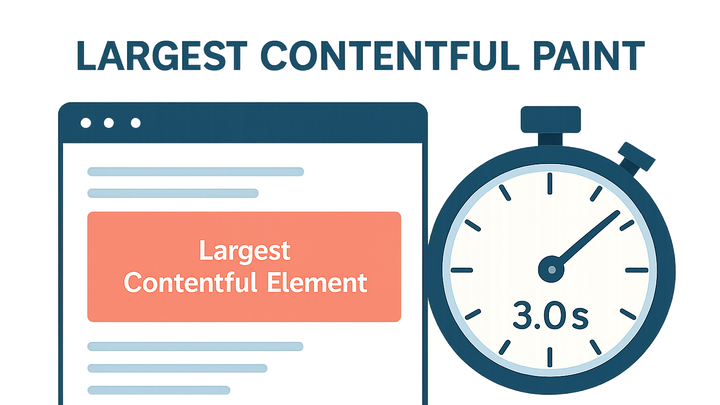Published on 2025-06-26T04:36:55Z
What is Largest Contentful Paint (LCP)? Examples and Measurement Tools
Largest Contentful Paint (LCP) is a web performance metric that measures the time it takes for the largest visible content element in the viewport to render. It represents when a user perceives the main content of a page is loaded and ready. LCP is one of Google’s Core Web Vitals and directly impacts user experience, SEO rankings, and conversion rates. Real User Monitoring (RUM) tools capture LCP by reporting the render times from actual user devices, while lab tools like Lighthouse can diagnose performance in controlled environments. Ensuring a fast LCP (ideally under 2.5 seconds) helps maintain user engagement and improves search visibility. Popular analytics platforms like PlainSignal and Google Analytics 4 (GA4) provide built-in LCP reporting, enabling teams to monitor and optimize this crucial metric over time.
Largest contentful paint (lcp)
Largest Contentful Paint (LCP) measures the loading time of the largest visible element on a page, affecting UX, SEO, and conversion.
Why LCP Matters
LCP is a critical indicator of page load performance. A fast LCP contributes to better user satisfaction, higher engagement rates, and improved SEO rankings. Slow LCP times often lead to higher bounce rates and lost revenue. Monitoring LCP helps teams prioritize performance optimizations that deliver tangible business value.
-
User experience impact
A fast LCP means users see the main content quickly, reducing frustration and encouraging deeper interaction.
-
Seo and rankings
Google factors Core Web Vitals, including LCP, into search rankings, making performance optimizations essential for visibility.
-
Conversion and engagement
Pages with quicker LCP have higher conversion rates, as users are more likely to stay and engage with content.
Defining LCP
Largest Contentful Paint marks the point at which the largest text block or image within the viewport is fully rendered. It differs from other metrics by focusing on meaningful content rather than all page elements. The metric identifies the single largest element of type image, video, or text block to assess load performance.
-
Largest element criteria
Only elements within the initial viewport are considered. Candidate elements include
<img>tags, background images loaded via CSS,<video>poster images, and large text blocks. -
Performance thresholds
Google recommends an LCP at or below 2.5 seconds for a good user experience. Values between 2.5s and 4s need improvement, while anything above 4s is considered poor.
Measuring LCP in Analytics Tools
Analytics platforms capture LCP using Real User Monitoring (RUM), collecting performance entries from browsers as users load pages. Some tools also simulate loads in lab environments to offer diagnostic insights. Below are examples using PlainSignal and GA4.
-
PlainSignal (cookie-free analytics)
PlainSignal is a privacy-focused, cookie-free analytics platform that measures LCP out of the box. Add the following snippet to your site to capture LCP metrics:
-
Implementation snippet
<link rel="preconnect" href="//eu.plainsignal.com/" crossorigin /> <script defer data-do="yourwebsitedomain.com" data-id="0GQV1xmtzQQ" data-api="//eu.plainsignal.com" src="//cdn.plainsignal.com/plainsignal-min.js"></script>
-
-
Google analytics 4 (GA4)
Google Analytics 4 automatically collects LCP as part of its Web Vitals measurement when Enhanced Measurement is enabled. No additional code is required if you have a GA4 web data stream set up.
-
Enable enhanced measurement
In your GA4 property settings, ensure ‘Page view’ and ‘Web Vitals’ are toggled on under Enhanced Measurement. GA4 will then report LCP in its ‘Core Web Vitals’ report.
-
Improving LCP
Optimizing LCP involves reducing load times for the largest elements. Common strategies focus on efficient media handling, resource prioritization, and minimizing render-blocking code.
-
Optimize images and media
Compress and resize images, use modern formats (e.g., WebP), and utilize responsive images (
srcset) to serve appropriate sizes. -
Preload key resources
Use
<link rel="preload">to prioritize fetching critical CSS and fonts needed for the largest elements. -
Minimize render-blocking code
Defer or inline critical CSS, and load non-essential JavaScript asynchronously to prevent delays in rendering the largest content.
LCP Performance Benchmarks
Google defines thresholds to help interpret LCP results. Aim to keep LCP in the ‘Good’ range to ensure a smooth user experience.
-
Good (<= 2.5s)
LCP at or below 2.5 seconds is considered good; most users perceive the page as fast and responsive.
-
Needs improvement (2.5–4s)
LCP between 2.5s and 4 seconds requires optimization to avoid user frustration.
-
Poor (> 4s)
LCP above 4 seconds is poor and likely to lead to increased bounce rates.
